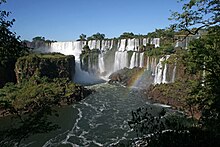Iguazú National Park
The Iguazú National Park is located in the north of Argentina and protects the part of the Iguazú Falls on the Argentinean side as well as the surrounding areas of the Atlantic rainforests . It was established in 1934 and covers an area of 677 square kilometers. In 1984 it was declared a World Heritage Site together with the Iguaçu National Park on the Brazilian side .
location
The park is located in northeast Argentina on the border with Brazil . The northern boundary of the park is formed by the Iguazú River. The closest town is Puerto Iguazú (about 17 km from the national park border). The national park itself covers an area of 677 square kilometers including a 63 square kilometer national reserve. The Iguaçu National Park, which borders on the Brazilian side, is about 1700 square kilometers. There are hardly any major elevations and the entire park area is around 150 to 170 m above sea level.
Climate and vegetation
The climate is subtropical and warm and humid with annual average temperatures of around 20 ° C, which are only slightly undercut in winter. The average annual rainfall is around 1,800 mm, with rain occurring all year round. Nevertheless, the rains between January and March are more productive. During this time the Iguazú also carries more water. The vegetation consists of forests, whereby three predominant types can be distinguished. Firstly, humid, subtropical, deciduous forests, secondly, humid subtropical rainforests, and thirdly, mist forests in the area of the waterfalls.
fauna

The national park is home to numerous endangered mammals, such as the jaguar , the largest big cat in South America . The jaguar population in the Atlantic jungle on the upper Paraná River is severely fragmented and continues to decline. The main cause is poaching , which reduces the jaguar's prey. A census that was carried out in the national park between 2004 and 2006 showed a population density of around one to two adult jaguars per 100 square kilometers. According to this, the stocks have declined two to seven times since the 1990s. Overall, the number of jaguars in the border area between Brazil and Argentina is estimated at 25 to 53 adults. Other large mammals of the reserve are Flachlandtapir , White-lipped Peccary, Capybara, brown howler monkey , tufted capuchin , Southern Tamandua , Giant Anteater , Ocelot , Southern tiger cat , Jaguarundi, Bush dog, coati, raccoon crab, giant otters, neotropical otter. The thick-tailed pouch rat is also at home in the park. In total, Iguazú National Park is home to at least 68 species of mammals, 422 species of birds, more than 40 species of reptiles, 18 species of amphibians, and 250 different species of butterflies. This means that around 44% of all Argentine bird species occur in the national park. Together with the Iguaçu National Park on the Brazilian side, it is home to 83 species that are endemic to the Mata Atlântica .
Cap blue raven in the national park
Giant Toucan in the national park
Individual evidence
- ↑ a b c UNEP-WCMC: IGUAZÚ NATIONAL PARK, ARGENTINA. World Heritage Sites, Protected Areas and World Heritage. Last update: May 2011 PDF ( Memento of the original from August 11, 2011 in the Internet Archive ) Info: The archive link was inserted automatically and has not yet been checked. Please check the original and archive link according to the instructions and then remove this notice.
- ↑ Agustín Paviolo Carlos Daniel De Angelo Yamil Edgardo Di Blanco and Mario Santiago Di Bitetti,: Jaguar "Panthera onca" population decline in the Upper Parana Atlantic Forest of Argentina and Brazil . Oryx (2008), 42: 554-561, doi : 10.1017 / S0030605308000641 .
Web links
- official website
- Administración de Parques Nacionales - National Parks Administration of Argentina (Spanish and English)
Coordinates: 25 ° 35 ′ 48.5 ″ S , 54 ° 1 ′ 20.1 ″ W.



